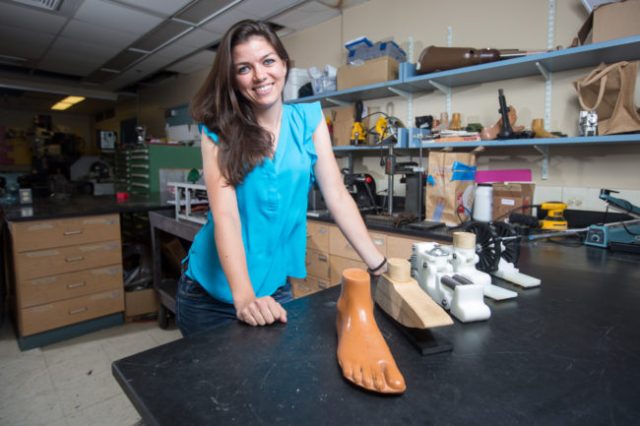
It’s no secret that there is a gender gap in the world of tech and invention. Women hold far fewer patents than men. A 2016 University of Washington study found that female students earn less than 20% of computer science and engineering degrees. The reasons for this gap include the perception that these fields are masculine, a gap in belief of one’s abilities, and lack of pre-college experience.
Because of this, the work of a team of six undergraduate women developing Tactile, an affordable, portable text-to-braille device, is all the more important. The team hopes to increase access to reading materials for those who are visually impaired. The team members are all MIT students pursuing degrees in engineering and related fields. Access to braille to increase the literacy rate is important; one study showed that while 30% of those who are blind are employed, 90% of that group are braille readers. As there are over 7 million people who are visually impaired in the United States, this type of affordable, portable technology can give those who are visually impaired the same access to text and information as anyone else.
The team is working with Microsoft and the #MakeWhatsNext Patent Program to help patent their device. Tactile also won $10,000 from the Lemelson-MIT Student Prize program, the first all-women team to win in the Use It! Category, which rewards inventors working on technology-based inventions that can improve consumer devices. A local ABC affiliate did a recent feature on them,showing their device in action, calling it “cutting edge”.
They aren’t the only young female winners of the 2017 Student Prize. Of the 18 undergraduate and graduate awardees, ten are women The young women recognized by the Lemelson-MIT Student Prize this year are working to solve real-world issues by applying creative thinking and technical skill. Here are a few more women who are representing the next generation of female inventors coming up through this innovative program:
Katy Olesnavage, inspired by her mother’s work as a physical therapist, took that dream a step further by inventing a process to design optimized prosthetic feet. Specifically, Katy works with a company in India to produce high performance, mass-producible, low cost feet to help the 5 million people in India living with lower limb amputations. Current prosthetic options have merely been “good enough” – she wanted to find the optimal foot for all users.
Like with running shoes, the features of a prosthetic foot varies from user to user based on their size and activity level. This work looks to optimize feet for many conditions, including the background research necessary to answer questions like, do women walk differently than men and therefore require a different type of performance from their prosthetic feet. Katy grew up not far from Detroit. Her mother would come into Katy’s elementary school and demonstrate how to use crutches, wheelchairs, and other mobility aides or assistive devices. In high school, Katy was encouraged to take her learning into her own hands.
Katy taught herself math from textbooks and enrolled in college math and physics course while still in high school. Motivated by the chance to make a real difference, Katy applied her passion for mechanical design, her strong work ethic, and her determination to help bring people across the world improved prostheses. Katy was awarded a $15,000 Lemelson-MIT Student Prize for her work. Aside from being an impressive inventor, Katy has locked up a job at SpaceX after she completes her PhD. No big deal…
Thousands of children die due to the poor biological water quality of water sources in India. Though filters that take out biological contaminants are widespread, they are often unused. Natasha Wright, a graduate MIT student, applied a nearly 70-year old technology to this issue and is helping to solve one of the biggest global health problems: access to clean, safe drinking water.
Wright found through research that the reason biological contaminant filters are unused is because they do not address how the water tastes. Natasha invented a groundbreaking solar-powered water desalination (“de-salting”) system that improves the quality of the water. This system offers affordable, safe drinking water to communities that do not have reliable access to electricity.
Lisa Tostanoski is a National Science Foundation Graduate Research Fellow in the Jewell lab, is combining immunology and engineering to address the shortage of effective and specific therapies for autoimmune diseases, such as multiple sclerosis. She is $15,000 ‘Cure It!’ Graduate category winner.
Maria Filsinger Interrante is a Stanford student, is working with two undergraduate students, known as Team Lyseia. They are working on a novel protein drugs to kill “superbugs” (multi-drug resistant, gram-negative bacteria). Multi-drug resistance to bacteria is expected to over take cancer in leading cause of death globally by 2050. When major pharmaceutical companies are shying away, Maria and her team are standing up to fight these infections. Maria and her team were the $10,000 ‘Cute It!’ Undergraduate category winners.
The program’s executive director, Dr. Stephanie Couch, has spent nearly two decades in the arena of STEM education policy. Through her work in the program, she hopes to elevate collegiate inventors to be role models for the next generation of scientists, engineers, mathematicians, and inventors. We spoke with her about the importance of programs like the Lemelson-MIT Prize and Student Prize, and why the economy needs more women in STEM.
As your role as Executive Director of the Lemelson-MIT Program, how has this program been key in elevating the visibility of young women in the STEM arena?
Each year we conduct a nationwide search to find applicants for our annual national student prize competition. We work especially hard to find young women and students underrepresented in STEM whose creativity and inventive mindsets have led to the development of a working prototype of a technological solution to a societal problem. This year, 10 out of 18 Lemelson-MIT Student Prize winners are women, with one winning undergraduate team of all women who invented a real-time text to braille converter.
All of these women saw a problem in the world that needed a better solution. Once we find women like these, we work to raise their visibility and enhance their support through the media. We also give young women in our middle and high school invention education programs opportunities to meet the prize winners and to hear first-hand how our successful female prize winners have navigated the ‘Pathway to Invention.’
As an expert in STEM education policies, what are some effective strategies you can see that will empower more girls, especially girls of color, to enter the STEM field?
We must find ways to make time during the regular school day for young women to apply what they have learned in STEM and other subjects to developing solutions to problems they care about. The Lemelson-MIT Program offers two invention education grants initiatives. Our Junior Varsity (JV) InvenTeams initiative are comprised of students in grades 7-10 who hone their hands-on skills and enrich their STEM education through invention-based design activities.
Many of these students are underrepresented in STEM and some of these students go on and enter our national InvenTeams grants initiative, which is a more vigorous invention education program of 15 teams of high school students, educators and mentors that receive up to $10,000 each to invent a technological solution to a real-world problem of their own choosing.
Many young girls who participate in our InvenTeam program decide to pursue STEM college and career pathways after seeing how STEM relates to their daily lives. Young girls report that their work in the team environment builds confidence and that they learn from failure. At the conclusion, many self-identify as leaders and as being creative.
At an academic level, there are quite a few women obtaining STEM degrees, but the disparity starts to take place in the workforce. How can programs like the Lemelson-MIT Program close that gap?
Invention is a major component of the innovation economy. STEM knowledge and skills are important, but leading innovators also need to be able to know how to find a good problem to solve, how to engage with people to fully understand the problem, and then must bring a diverse set of knowledge and skills to bear in designing a solution and building a working prototype. STEM knowledge is not enough. Our invention education programs help young women develop in these areas.
As they go through the process, they recognize the range of knowledge and skills they bring to their teams (such as creativity). Their confidence in their ability to work in STEM and confidence in their leadership skills grows. We also bring the high school InvenTeam members to MIT to engage with our collegiate award winners so that young women can ‘connect’ with ‘near peer’ female role models. All of these help with preparing young women for the workforce.
How have some of the past inventions gone on to make a bigger impact in the STEM world?
One of our past high school inventors, Kavita Shukla, won our 2002 Invention Apprentice award for her patented invention, FreshPaper. Fresh Paper is a low-cost, compostable paper that keeps produce fresher longer. It is now sold through stores nationwide and online through her website Fenugreen.com. Five high school InvenTeams have been awarded U.S. patents for their invention. This is quite an achievement for a high school student since the average patent holder received their first patent at the age of 30. We are also proud of InvenTeam students, such as Lise Clara Mabour, who returned to her high school as a science teacher and has applied to serve as her students’ InvenTeam advisor in the year ahead.

How do you hope to engage more girls to enter the competition and showcase their STEM skills?
In addition to our prize programs recognizing outstanding young inventors, the Lemelson-MIT Program offers two invention education programs for middle and high school students. While all students benefit, our research shows that young women and students from underrepresented backgrounds benefit the most. Many young women that have participated decided that they would pursue a STEM degree and have continued to invent. We want to grow our invention education programs so that young girls across the United States get the opportunity to participate as part of their regular school day.
From an economic standpoint, why is it imperative the STEM industries work to engage more women and minorities in the workforce?
STEM industries in the United States can benefit from the unique perspectives and insights into the needs of customers and potential solutions that women and minorities bring to innovative teams. Recent studies suggest that only 10 percent of leading innovators are female and roughly 5 percent are from ethnic backgrounds other than English or Asian. Enhancing diversity in STEM industries will open up opportunities for new discoveries and new solutions to problems.
================================================================================
Click on the following links to find out more about the Lemelson-MIT Student Prize and the Lemelson-MIT Program.

















